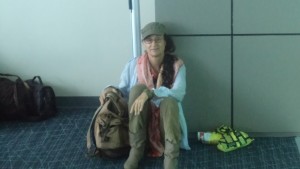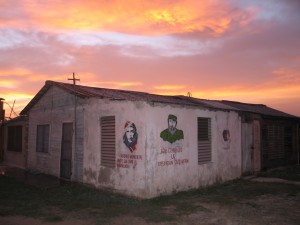.
We’re back in Cuba!
Last year was our first time in Cuba, a location we selected because of its proximity to Nicaragua, wanting to visit before the US embargo is finally lifted, with the prospect of hordes of American visitors. But, importantly, there is also strong motivation in the fact that Cuba is for the most part “internet free”. While to most this might seem like a short-coming, for us, after an arduous year of CO2 Bambu start up stress, “disconnecting” from the world seems like an attractive feature. What we discovered was a land operating at a different speed, a sort of time travel at least fifty years back, that took us to Habana and provinces to the Far West (Vinales, Trinidad…). We agreed it would be worth coming back to experience the Western Orient and central Cuba.
.
A year later, the attraction of disconnection from internet resonates again, and with tickets at a historic low ($180 from Managua, via Panama), we jump on the opportunity to return.
.
Cuba occupies a very unique place in the pantheon of exotic tourism. With the bulk of the US tourist “market” absent from Cuba, due to the US embargo, the island has developed as a tourism destination for Canadians and Europeans that combines the search for sun, for architectural charm and for “something different”. The Cuban government has been prompt to jump on the opportunity to create a national infrastructure that attracts ever growing throngs of international visitors. BUT, to do this, and adhere to its economic and political model, the government has opted to create strong guidance in terms of what constitutes “tourist worthy” destinations on the island.
.
Problem is: we are neither the typical tourists, in fact preferring to think of ourselves as “travelers” rather than “tourists”, nor do we operate in the economic zone which tourists come from. The result is that what the government puts forward in its push for tourism ain’t for us.
.
When talking to US, Canadian and European tourists about Cuba, the surprising recurring comment that we hear is “Cuba is so expensive”. Nothing could be further from the truth, if one is of course willing to enjoy the country in its true form, not in the format that has be pre-packaged by well meaning Cuban authorities.
.
The following entries speak to traveling Cuba “on the cheap”. For this, we have a major trump card. We call it “the Nicaragua factor”.
.
A typical conversation goes like this:
“How much to go from point A to point B?”
“Well it’s far and oil is expensive these days, so $60”
“$60?! No, we can’t do that, it’s much too much”
“Well, it’s Tuesday, it’s end of the year, for you, I’ll give you a ride for $50”
We then typically go to our Casa Particular and ask if there are buses, or other public transport.
“No!” There are no buses, you can only go by taxi, and the price is between $50 and $60”.
Then in the ultimate round we pull the Nicaraguan card… “Peta’s South African, Ben is French, but we live in Nicaragua and we live on Nicaraguan salary”
“Ahhhhh, you are from NICARAGUA?!!!”
.
Then the flood gates open..
.
“Let me call my uncle, my sister, my neighbor… she knows someone who needs to go there, maybe you can share the taxi ride”
Or
“Well there ARE Wawas — buses for trabajadores (worker’s buses), but you are from Nicaragua, so you won’t mind….”
.
This exchange takes place multiple times during the trip, slashing our costs for hotels and transportation.
.
The feeling of kinship between Cubanos and Nicaraguans runs thick. In the 80’s many Cuban advisors / soldiers were sent to Nicaragua to help Ortega fight the CIA-supported Contras. Even today, the Cuban footprint in Nicaragua is significant. One of the most tangible positive impacts Cuba has on Nicaragua is through its thoroughly impressive “brigadas de salud” – health brigades, which the Cuban government sends to allied countries. Our doctor in Granada is Cuban.
.
The Nicaragua factor therefore is critically important in helping us bridge between the “we” and “them” that divides Cubans from tourists. As pseudo-Nicaraguans, we fall automatically closer to the “we”. We are invited to share rum. We walk into homes comfortably to chat with Cubanos. We discuss life in Cuba and in Nicaragua, and the dimensions of the Socialist model in Latin America in the year 2012, something rarely achievable in the scripted “all inclusive resorts” tourism model. Several times the conversation turns to Hugo Chavez hospitalized in Cuba…
.
Our budget for Cuba has been $25 per night for Casas Particulares, and $10 per person for great dinners. We typically graze on the plentiful organic greens in addition, that Peta picks up along the way. The rest of the expenses are for transport, and with a bit of perseverance and a willingness to “go local”, Cuba turns out to be affordable and the experience is richly rewarding. Authenticity is omnipresent. The desire for honest, direct contact with the “outside world” leads to warm and engaging conversations.
.
Geographically, we land in La Habana (1), whisk off directly by domestic flight to Holguin (2). From vibrant, urban Holguin, we make our way slowly through central Cuba, through the architecturally impressive Camaguey (3), to small side jaunts like Gibara, an almost abandoned coastal town, to world class beaches along the many “cayos” (keys) (4) with miles of powder white sands, to sleepy Remedios (5), along the coast, leading to the Jardines del Rey (King’s Gardens) for beaches and bio-reserves.
Along the way, we have numerous encounters with the most genuinely nice and welcoming people we have met in our Latin American travels – so proud of their history and of their resilience. Of great interest to us, given the focus of our Green Global Trek, are the many small reminders of Cuba’s forward leaning, environmental mindset and policies. Because of the particular constraints established by the US Embargo, the island has developed a comprehensive culture around recycling, re-using and low consumption patterns.
.
Of all the places we have visited, Cuba is by far the most “Peak Oil” ready. This is seen through the national network of municipally organized “urban farming”, with micro-organic farms dotting the landscape in addition to sugar cane, rice and banana and coconut plantations.There are not many new cars, especially as you leave the cities and venture into the countryside. Vintage old cars, bicycles, bicitaxis and horse and carts are common transportation. Transport by hitch-hiking is common. Most impressive of all is the nation-wide network of urban gardens that have been set up, to deal with the collapse of the formal food supply chain after fertilizer no longer was available due to the US embargo and fall of the Berlin Wall, making Russia no longer the source of funding it once was.
.
“It is preferable to die standing up, than to live on your knees”
Che Guevarra





More vicarious thrills! Interesting about the urban farms. Did you see chickens and other farm animals in the cities as well?
We did see chickens and a few other random animals… But it was the greens we were after! Glad you are enjoying!
I’m so glad I waited a short time before jumping on the initial American bandwagon to get to Cuba. Those trips were all planned out, super expensive, and I recoiled from them even though I was desperate to get there sooner rather than later. Now we can fly in on our own (so cheap!) and book our own stays in the casas. We still have to have an “official” reason for visiting to get our visa but that’s a cinch. I’m psyched to go! You have a zillion posts – I started here for no good reason but will go browse awhile at many others!
Thanks for commenting here Lex. Yup we have a zillion posts because we were so entranced with Cuba and we had so much to say. Great that you finally got to do your Cuba trip! Hope you enjoyed the posts on Cuba and that they were helpful in your planning….
We weren’t getting many comments at this point in time ( unfortunately, as I think the Cuba entries were some of our best!)
Peta